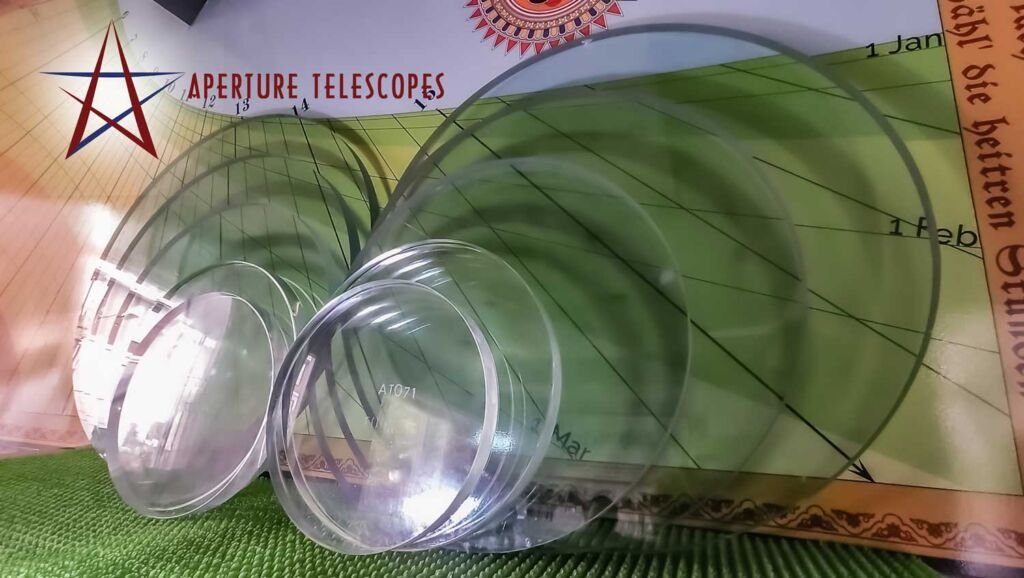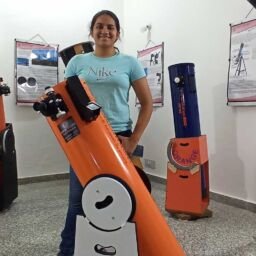It is a common question among telescope buyers, ‘Which glass is used for the primary mirror?’
At Aperture Telescopes we make our mirrors from Float Glass, unless specifically requested.

Let’s see what are the factors involved in making telescope mirrors out of Float Glass.
Distortion of Mirror’s Surface – The main physical issue with any glass used in telescopes is the distortion suffered when temperature changes. Glass changes in size as its temperature changes. Although the amount of change in size is always small, but it can be significant when compared with the wavelength of light. The term used is ‘Coefficient of Thermal Expansion’ and it is measured in parts per million per degree centigrade.
When the ambient temperature around the telescope changes, for example if you move the telescope from the cool insides of your house, to the warm outdoors, or the warm terrace, or if you have taken your telescope in your car for a dark location and then take it out, there will be a temperature change. As there is a change in the ambient temperature, the surface of the mirror will adapt to the temperature. The glass which is deeper inside will take longer to adapt. The temperature gradient within the mirror will distort the surface, and the parabolic curved surface will no longer be in correct shape that the mirror make intended to be. The telescope will not provide sharp images until the mirror temperature equalises throughout its thickness.
In normal conditions, many Indian cities do not experience extreme temperature differences between the outdoors and indoors. Winters in the north part of India may have low temperatures for brief periods. In the Himalayas too it gets quite cold, but since the houses are not centrally heated the temperature difference between indoor and outdoor is not extreme.
In telescopes of 12-inch and smaller sizes the thermal expansion of plate glass does not cause any practical problems. Plate glass also does take a smoother polish, less micro ripple. A smoother finish in a telescope mirror provides a greater contrast when observing.
Active cooling is one key to reflector performance, regardless of whether the primary mirror is made from Pyrex or plate glass.
The bottom line? Pyrex is slightly better than plate glass in theory, but not in practice for small telescopes. Ventilation is far more important.
INFAMOUS TELESCOPE MYTH
(Sky & Telescope – February 2002)
Here is a notoriously long-lived telescope myth. It contains a grain of truth. Yet it is demonstrably incorrect and may have caused many a telescope owner unnecessary effort, expense, or angst.
“Pyrex telescope mirrors are better than those made from plate glass.”
The primary mirror at the heart of a reflecting telescope is typically made from either Pyrex or ordinary plate glass. Both materials can be fashioned into excellent mirrors. So why is it so commonly held that Pyrex mirrors are inherently superior? There are two main reasons.
First, because plate glass is less expensive, it is presumed inferior — you get what you pay for, right? However, in truth the cost of the substrate material has little to do with the price of the finished mirror. Most of the expense lies in turning that piece of glass into a working optical component.
Second and more to the point, unlike plate glass, Pyrex is a low-expansion material. This means that a mirror made from Pyrex is less prone to warping when it is at a different temperature than the air surrounding it. The ultraprecise curve on the surface of a Pyrex mirror isn’t as severely deformed when the telescope is moved from a warm house into the cool night air.
This relative insensitivity to temperature changes also has its advantages when the optician carefully refines (or figures) the curve on the mirror’s polished surface. When the glass is worked, a certain amount of heat is generated by friction between the tool and the mirror. Because this heat will deform Pyrex less than plate glass, the optician doesn’t have to wait as long to test the mirror and proceed to the next figuring step. Since a commercial firm presumably wants to minimize the time spent on an individual mirror, some amateurs assume that a Pyrex mirror will turn out better than one made from plate glass.
This sounds logical enough, but I have seen no evidence of it in the dozens of mirrors I have tested over the years. In any case, these attributes are more of an issue for the optician than for the mirror user. If you’re making a mirror, Pyrex does have its advantages, but if you’re simply buying or using one, these characteristics really shouldn’t come into play.
“But don’t Pyrex mirrors cool faster than plate-glass ones?” Yes, but the difference is not nearly enough to be significant in most amateur-size mirrors. In theory, Pyrex should cool about 20 percent faster than plate glass. But other factors — notably the mirror’s thickness and the design of its cell — are far more important.
There’s yet another reason why glass type makes little difference: when it comes to thermal problems, your main enemy is the layer of warm air in front of the primary mirror. No mirror, regardless of glass type, will perform adequately until this “boundary layer” goes away. Temperature-related deformations of a mirror’s figure are minor compared to the boundary layer’s deleterious effects. Venting the primary mirror — ideally with fans, can help you get rid of this problematic air layer.
(Reference – https://skyandtelescope.org/astronomy-resources/four-infamous-telescope-myths/)









Thank you for sharing this!!
I had no idea cooling the mirror was this critical.
I just assembled my scope a couple of hours before I planned to use it and that’s it.